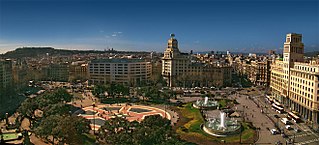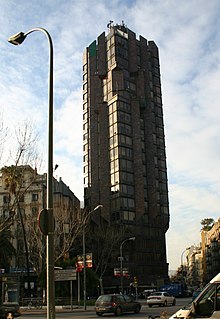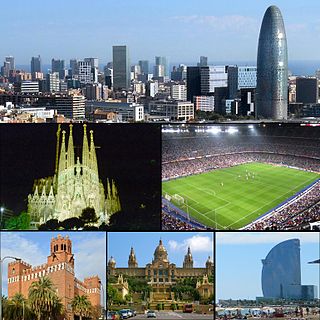
The Trambaix is one of Barcelona's three tram systems. It is operated by TRAMMET connecting the Baix Llobregat area with the city of Barcelona, Catalonia, Spain. It opened to the public on 5 April 2004 after a weekend when the tram could be used free of charge.

Gran Via de les Corts Catalanes, more simply known as Gran Via[ˈɡɾam ˈbi.ə], is one of Barcelona's major avenues. With a length of 13.1 km (8.1 mi), it is the longest street in Catalonia and the 2nd longest in Spain, after Gran Vía de la Manga, in La Manga del Mar Menor, but is the one with more street numbers in Spain.

Line 1, shortened to L1, coloured red and often simply called Línia vermella, is the second oldest Barcelona Metro line, after line L3. It is the longest line of the Barcelona Metro, and links L'Hospitalet de Llobregat and Santa Coloma de Gramenet. Originally operated by the independent Ferrocarril Metropolitano Transversal de Barcelona, it is today operated by Transports Metropolitans de Barcelona (TMB) and is part of the ATM fare-integrated main transport system. L1 is the only metro line in Spain to use Iberian gauge tracks, as used by most Spanish main line railways.
— Line 8, coloured pink and operated by FGC, is part of the Barcelona Metro network, and therefore of the larger ATM fare-integrated transport system. It joins Plaça Espanya, in the Sants-Montjuïc district of Barcelona with metropolitan area municipalities of L'Hospitalet de Llobregat, Cornellà de Llobregat and Sant Boi de Llobregat.

Avinguda Diagonal is the name of one of Barcelona's broadest and most important avenues. It cuts the city in two, diagonally with respect to the grid pattern of the surrounding streets, hence the name.

Plaça de Catalunya is a large square in central Barcelona that is generally considered to be both its city centre and the place where the old city and the 19th century-built Eixample meet.

Via Laietana is a major thoroughfare in Barcelona, Catalonia, Spain, in the Ciutat Vella district. The avenue runs from Plaça Urquinaona to Plaça d'Antonio López, by the seafront, and separates the neighbourhoods of the old city it has on either side: La Ribera/El Born and Sant Pere on one and Barri Gòtic on the other. Besides being always overcrowded with both locals and tourists attracted by its Modernista Art Nouveau, Art Déco, and Noucentista neo-classical architecture, in addition to its nearness to the Ramblas and the quiet pedestrian streets of Barri Gòtic, Via Laietana hosts the headquarters of a number of banks and institutions.

The Plaça d'Urquinaona is one of the principal squares in central Barcelona. It is officially part of Dreta de l'Eixample neighbourhood, in the Eixample district, and is located at the intersection of the Ronda Sant Pere and Carrer d'Ausiàs Marc.

Passeig de Sant Joan is a major avenue in the Eixample and Gràcia districts of Barcelona. It was named after an older street carrying this name, also known as Passeig Nou, built in 1795 around the glacis of the Ciutadella fortress.

Plaça de Lesseps is a square serving as the border between the Sarrià-Sant Gervasi and Gràcia district of Barcelona, Catalonia, Spain, loosely divided in two parts. One of the most heavily transited squares in the city, Lesseps is the starting point of one of Barcelona's busiest rondes: Ronda del General Mitre, as well as being the west end of Carrer Gran de Gràcia and being crossed by a number of streets, namely: Travessera de Dalt, Avinguda del Príncep d'Astúries, Avinguda de Vallcarca, Avinguda de la República Argentina, Carrer del Torrent de l'Olla, Carrer de la Mare de Déu del Coll, Carrer de Santa Perpètua, Carrer de Maignon and Carrer de Pérez Galdós.

Collblanc is a station on line 5 and line 9 of the Barcelona Metro.

Plaça de Francesc Macià is a square in Barcelona, Catalonia, Spain. Located in one of the main business areas of the city, it is one of the most transited points of Barcelona. It is crossed by Avinguda Diagonal and several other major thoroughfares: Avinguda de Josep Tarradellas, Travessera de Gràcia, Carrer del Comte d'Urgell and Avinguda de Pau Casals. It is part of the Sarrià-Sant Gervasi district, even though it borders two other districts of Barcelona: Les Corts and Eixample.
Avinguda de Josep Tarradellas, often known as just Avinguda Tarradellas, is an avenue in Barcelona. Most of it is in the Les Corts district of the city, while the rest acts as the border of two other districts: Sants-Montjuïc and Eixample. It starts at Plaça dels Països Catalans, by Barcelona Sants railway station, and ends at Plaça de Francesc Macià.

Guinardó | Hospital de Sant Pau is a station of the Barcelona Metro, on L4, serving Ronda del Guinardó and Plaça del Guinardó. It opened in 1974. The station is due to become part of double line L9-L10 in the near future.
The line VI of the Barcelona Metro network was a 1965 ambitious project for a proposed underground railway line in the city of Barcelona. The line would stretch from the Zona Franca towards Plaça de Francesc Macià, and from there into Travessera de Gràcia, Glòries, the Besòs River area, northern Badalona, and Montigalà in Santa Coloma de Gramenet. This very costly project was progressively abandoned: at first, in 1984, through the revision of the line making it shorter. Later, in 1996, a new plan was devised for the city's public transport infrastructures. In 2001 yet another plan (PDI) was put forward, discarding the line, and proposing other transport projects instead.

Travessera de Dalt is an important and much-used street in Barcelona. It spans a good deal of the city's district of Gràcia, starting at the tunnel entrances at Plaça de Lesseps, and running towards the tunnels system near Plaça Sanllehy, where it changes name and merges into Ronda del Guinardó. It's formally part of the ring road Ronda del Mig, which splits into several smaller roads.

Francesc Macià is a Trambaix station and a projected metro station located in the Plaça de Francesc Macià, Barcelona, crossed by the Avinguda Diagonal, in the Sarrià-Sant Gervasi district. This stop is the terminal for the three Trambaix routes.

The following outline is provided as an overview of and topical guide to Barcelona:






















